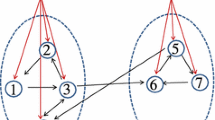Abstract
This paper investigates cluster synchronization of a class of multi-agent systems with a directed bipartite graph topology, and presents a number of new results by using the neighbor’s rules for the following two cases: I) there is competition among the agents of different clusters, and II) there are both competition and cooperation among the agents. Firstly, for case I), a linear control protocol is designed for cluster synchronization of multi-agent systems, and a method is presented to determine the final state with the initial conditions based on state-space decomposition. Secondly, we study case II), and design a control protocol based on the information of neighbors and that of two-hop neighbors (that is, neighbors’ neighbors). Finally, two examples are studied by using our presented results. The study of illustrative examples with simulations shows that our results as well as designed control protocols work very well in studying the cluster synchronization of this class of multi-agent systems.
Similar content being viewed by others
References
Fax J A, Murray R M. Information flow and cooperative control of vehicle formations. IEEE Trans Autom Control, 2004, 49: 1465–1476
Hao H, Barooah P, Mahta P G. Stability margin scaling laws for distributed formation control as a function of network structure. IEEE Trans Autom Control, 2011, 56: 923–929
Ni W, Cheng D Z. Leader-following consensus of multi-agent systems under fixed and switching topologies. Syst Control Lett, 2010, 59: 209–217
Wang Y, Zhang C, Liu Z. A matrix approach to graph maximum stable set and coloring problems with application to multi-agent systems. Automatica, 2012, 48: 1227–1236
Hong Y G, Hu J P, Gao L X. Tracking control for multi-agent consensus with an active leader and variable topology. Automatica, 2006, 42: 1177–1182
Tanner H G, Jadbabaie A, Pappas G J. Flocking in fixed and switching networks. IEEE Trans Autom Control, 2007, 52: 863–868
Su H S, Wang X F, Lin Z L. Flocking of multi-agents with a virtual leader. IEEE Trans Autom Control, 2009, 54: 293–307
Saber R O. Flocking for multi-agent dynamic systems: algorithms and theory. IEEE Trans Autom Control, 2006, 51: 401–420
Lee D, Spong M W. Stable flocking of multiple inertial agents on balanced graphs. IEEE Trans Autom Control, 2007, 52: 1469–1475
Li T, Zhang J F. Asymptotically optimal decentralize control for large population stochastic multi-agent systems. IEEE Trans Autom Control, 2008, 53: 1643–1660
Zhang Y, Tian Y P. Consentability and protocol design of multi-agent systems with stochastic switching topology. Automatica, 2009, 45: 1195–1201
Zhang Y, Tian Y P. Consensus of data-sampled multi-agent systems with random communication delay and packet loss. IEEE Trans Autom Control, 2010, 55: 939–943
Kale N V, Salapaka S M. Maximum entropy principle based algorithm for simultaneous resource location and multi-hop routing in multi-agent networks. IEEE Trans Mob Comput, 2011, 1–12
Sun Y G, Wang L. Consensus of multi-agent systems in directed networks with nonuniform time-varying delays. IEEE Trans Autom Control, 2009, 54: 1607–1613
Ren W, Beard R W. Consensus seeking in multiagent systems under dynamically changing interaction topologies. IEEE Trans Autom Control, 2005, 50: 655–661
Saber R O. Distributed Kalman filter with embedded consensus filter. In: IEEE Conference on Decision and Control, 2005 and 2005 European Control Conference (CDC-ECC’05), Seville, 2005. 8179–8184
Yang T, Sun Y F. The reconstruction of gene regulatory network based on multi-agent systems by fusing multiple data sources. In: IEEE International Conference on Computer Science and Automation Engineering (CSAE), Shanghai, 2011. 126–130
Saber R O, Shamma J S. Consensus filters for sensor networks and distributed sensor fusion. In: IEEE Conference on Decision and Control, 2005 and 2005 European Control Conference (CDC-ECC’05), Seville, 2005. 6698–6703
Ren W, Cao Y C. Distributed Coordination of Multi-agent Networks. London: Springer-Verlag, 2010. 36–41
Xia W G, Cao M. Clustering in diffusively coupled networks. Automatica, 2011, 47: 2395–2405
Ma C Q, Zhang J F. Necessary and sufficient conditions for consensusability of linear multi-agent systems. IEEE Trans Autom Control, 2010, 55: 1263–1268
Yu J Y, Wang L. Group consensus in multi-agent systems with switching topologies and communication delays. Syst Control Lett, 2010, 59: 340–348
Xiao Y N, Chen L S. Stabilizing effect of cannibalism on structured competitive system (in Chinese). Acta Math Sci, 2002, 32: 210–216
Mao K, Li R H. The stability analysis of population competition model (in Chinese). J Biomath, 1999, 14: 288–292
Yu W W, Cao J D, Chen G R, et al. Local synchronization of a complex network model. IEEE Trans Syst Man Cybern Part B-Cybern, 2009, 39: 230–241
Author information
Authors and Affiliations
Corresponding author
Rights and permissions
About this article
Cite this article
Wang, Q., Wang, Y. Cluster synchronization of a class of multi-agent systems with a bipartite graph topology. Sci. China Inf. Sci. 57, 1–11 (2014). https://doi.org/10.1007/s11432-012-4689-1
Received:
Accepted:
Published:
Issue Date:
DOI: https://doi.org/10.1007/s11432-012-4689-1




